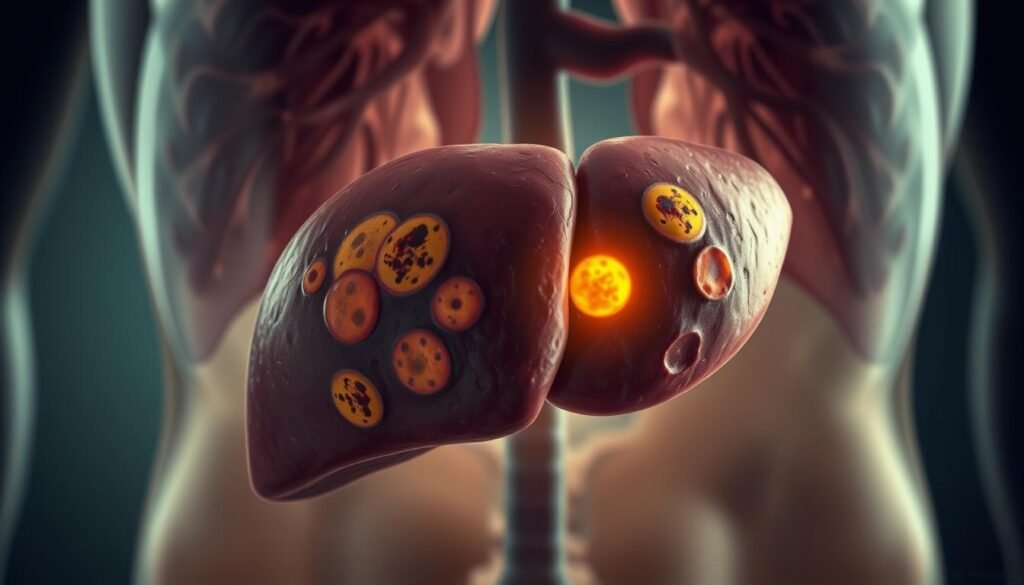Did you know lung cancer causes around 12.2% of all new cancer cases in the U.S.? This fact shows how crucial it is to understand lung cancer. Especially how it spreads to the liver and impacts patient outlook and treatment options. When lung cancer reaches the liver, known as liver metastasis, the prognosis worsens for many. This condition can stem from both small-cell lung cancer (SCLC) and non-small cell lung cancer (NSCLC), making patient outcomes grim.
This piece will explore the intricate ways cancer spreads, the specific impact of liver metastasis, and its effect on life quality. For those looking deeper into small-cell lung cancer, more information is available here.
Key Takeaways
- Lung cancer accounts for 12.2% of new cancer cases in the U.S.
- Metastasis to the liver significantly worsens prognosis and patient quality of life.
- Both SCLC and NSCLC can lead to liver metastases.
- Identifying liver involvement is crucial for treatment planning.
- Support for patients facing liver metastasis is essential for enhanced quality of life.
Understanding Lung Cancer and Its Types
Lung cancer comes in mainly two forms: small cell and non-small cell. Non-small cell lung cancer is the most common. It accounts for about 85% of all cases. Small cell lung cancer makes up 15%. It grows and spreads fast, making it aggressive.
Non-small cell lung cancer has different kinds, like adenocarcinoma, squamous cell, and large cell carcinoma. Each one is unique, so knowing the exact type is crucial for the right treatment. Small cell lung cancer, on the other hand, is often linked to smoking. This link is why it tends to grow and spread quickly.
Knowing the type of lung cancer is essential, but other issues can make diagnosis hard. Lung nodules can be harmless or a sign of cancer. Usually, bigger nodules are more likely to be cancerous. Mediastinal tumors, growing from different tissues, can be benign or cancerous too.
Dealing with a lung cancer diagnosis, like Wendy did, demands strength. She’s been fighting advanced lung cancer and liver cancer for over seven years. Wendy’s journey shows how vital personalized treatment is. It’s all about finding the right approach for each type of lung cancer.
The Process of Metastasis
Understanding the process of cancer metastasis is crucial for knowing how lung cancer affects the body. This journey starts when cancer cells leave the original tumor, invade nearby tissues, and spread via the bloodstream to distant parts like the liver. These travels can change how doctors manage care and predict outcomes.
Research shows that about 40% of lung cancer patients have metastases at diagnosis. The liver, lymph nodes, brain, bones, and adrenal glands are common targets. The presence of metastases in several places at once complicates treatment.
Liver metastasis in lung cancer patients is serious. For example, lung cancer that reaches the liver is considered stage 4 non-small cell lung cancer. This calls for detailed scans such as CT or MRIs to find liver metastases. These scans are vital to tell if growths are cancerous or not.
The outlook for a patient can be impacted by various tumor markers. A 2019 study showed that patients with EGFR-positive tumors and liver metastases lived about 11.7 months. That’s much longer than the 4.1 months for patients with EGFR-negative tumors. Thanks to targeted therapy and new treatment combinations, survival rates are improving.
Despite metastasis hurdles, new treatments are available. Techniques like stereotactic body radiotherapy (SBRT) help manage liver metastases. SBRT can trigger immune responses that may help fight tumors elsewhere in the body.
How Lung Cancer Can Spread to the Liver and Affect Prognosis
Lung cancer, like adenocarcinoma and small cell lung cancer, often spreads to the liver. This is called hepatic metastasis. It happens when cancer cells travel through the blood and reach the liver. The chance of liver involvement goes up due to the nature of the cancer and any liver issues present. It’s important to know how lung cancer can spread to the liver. This knowledge helps in managing the condition in patients.
Mechanisms of Hepatic Metastasis
The spread of lung cancer to the liver involves several steps and factors. Things like how aggressive the tumor is and the liver’s blood vessel layout matter. Studies show that up to 20.3% of small cell lung cancer patients get liver metastases. For adenocarcinoma patients, liver problems often appear late. This late appearance makes treating the cancer much harder.
Statistics on Liver Involvement in Lung Cancer
Statistics shed light on how liver involvement affects lung cancer patients. They show a grim picture for those with liver metastasis, with survival at about three months. This is much shorter than if the cancer spreads elsewhere. This gap highlights the need for treatments that cater to individual needs. For more info on how liver metastasis affects survival, check this study.
Symptoms of Liver Metastases
Those with liver metastases might face symptoms that change their life quality. Common signs include:
- Loss of appetite
- Fatigue
- Fever
- Jaundice, characterized by yellowing of the skin and eyes
- Abdominal bloating
- Swelling in the legs
- Upper right abdominal pain
It’s vital to recognize these symptoms early. Patients need to watch for any health changes. They should see a doctor quickly for a check.
In severe cases, patients might get very confused or even fall into a coma. This is called hepatic encephalopathy. It shows how critical it is to get help right away.
Seeing health go downhill as cancer grows can be very tough. It’s key to talk openly with doctors. This helps create a tailored plan to manage symptoms. Such strategies help control symptoms and improve life quality.

| Symptom | Details |
|---|---|
| Loss of Appetite | Often leads to weight loss and nutritional deficiencies. |
| Fatigue | Can inhibit daily activities and decrease overall energy levels. |
| Jaundice | Indicates compromised liver function, requiring immediate intervention. |
| Abdominal Pain | Can result from liver swelling or pressure on surrounding organs. |
| Confusion | Sign of hepatic encephalopathy affecting mental state. |
Being educated about these *liver metastasis symptoms* is important. It lets people seek the right care and decide on their treatment. Catching and managing these symptoms early greatly helps in cancer treatment.
Diagnosis of Lung Cancer with Liver Metastasis
Doctors need many tools to pinpoint lung cancer that has spread to the liver. They use scans, tests, and biopsies. This helps understand how far the cancer has gone and choose the right treatments.
Important Diagnostic Tools
To find liver spread in lung cancer, doctors use several key tools:
- CT Scans: Important for seeing tumors in the liver and nearby areas.
- MRI: Offers clear pictures of the liver to spot and measure tumors.
- PET/CT Scans: Shows active cancer by combining images with metabolic data.
- Blood Chemistry Tests: Checks liver health and looks for issues.
- Biopsies: Confirms if the cancer has reached the liver.
These tools are vital for detecting liver metastases. They give doctors detailed information about the cancer’s stage and growth.
Determining the Stage of Cancer
Cancer stage is key to figuring out treatment and chances of recovery. Staging considers tumor size, lymph node status, and if it’s spread far. With lung cancer going to the liver, staging helps in making treatment plans. It’s split into:
- Stage I: Cancer is only in one place.
- Stage II: Spread to nearby lymph nodes.
- Stage III: Wide spread in the region.
- Stage IV: Spread to distant parts like the liver.
Lung cancer with liver spread means stage IV. This is vital for choosing treatments and talking about the future. Knowing the exact stage helps doctors predict results and tailor treatments better.
Treatment Options for Lung Cancer Spread to the Liver
When lung cancer spreads to the liver, treating it becomes more difficult. A mix of lung cancer treatment options is often needed. These options depend on how much the cancer has grown and the patient’s health. A team of doctors will work together to treat both the lung and liver cancer.
Chemotherapy is usually a key part of treatment after surgery. Its goal is to kill any cancer cells left behind. Doctors may combine chemotherapy with radiation to get better results. This is especially true for people with a lot of cancer spread. For cancers in one area, stereotactic body radiotherapy is another choice.
Targeted therapy is another approach. It attacks specific parts of cancer cells. This method works well for cancers that have come back or spread a lot. Immunotherapy is also an option. It boosts the body’s defenses to fight the cancer. It’s useful when surgery isn’t an option.
It’s important to make treatment plans based on what the patient needs and wants. Liver metastasis treatment choices also help improve life for those with advanced cancer. This is key in care that aims to ease symptoms.

Factors Influencing Prognosis
Lung cancer prognosis factors are vital in understanding patient outcomes, especially when the disease spreads to the liver. These factors help determine a patient’s treatment response and survival. Key elements include:
- Tumor Type – The type of lung cancer makes a big difference. Small cell lung cancer (SCLC) and non-small cell lung cancer (NSCLC) have different survival rates. SCLC, for example, is 14–17% of lung cancers but has a less than 7% five-year survival rate.
- Age – Older patients, those 65 or more, usually have worse outcomes than younger ones.
- Overall Health Status – Other health conditions and general health greatly affect prognosis. They influence treatment options and how well one might respond.
- Metastasis – Liver metastases are a severe concern. Patients with this issue often have a median survival of just 3.0 months.
- Treatment Response – A patient’s reaction to treatments like chemotherapy, targeted therapy, or immunotherapy greatly influences their prognosis.
Learning about lung cancer prognosis factors helps in setting clear expectations. It gives a broad view of the disease. Differences in survival based on patient age, tumor type, and other factors make treatment choices complex. Specifically, those with SCLC and liver metastasis have a very low 1-year survival rate of 14.5%.
Survival Rates for Patients with Liver Metastases
Patients with liver metastases from lung cancer face tough challenges. The outlook is often bleak, especially for those with non-small cell lung cancer (NSCLC) and small cell lung cancer (SCLC) that has spread. The five-year survival rates for lung cancer with liver metastases are quite low.
Five-Year Survival Rates According to Cancer Stage
Survival rates change with different cancer stages. For NSCLC patients with liver metastases, survival prospects depend heavily on the stage at diagnosis. Key survival figures are as follows:
| Cancer Stage | Five-Year Survival Rate |
|---|---|
| Localized | 37% |
| Regional | 14% |
| Distant | 4% |
| All SEER stages combined | 22% |
Several factors affect a patient’s prognosis. Age, overall health, how well treatment works, and unique patient traits matter. Patients caught at an early stage may be candidates for surgery, raising survival chances. However, those with serious health issues, facing advanced NSCLC and liver metastasis, have a grim outlook. They often have a median survival under three months.
Knowing these survival rates is key to understanding the patient’s challenges. It highlights the critical need for early detection and intervention.
Palliative Care and Quality of Life Considerations
Palliative care improves the lives of cancer patients, mainly those with advanced lung cancer and liver metastases. It focuses on physical, emotional, and psychological needs. This care involves a dedicated team of doctors, nurses, and social workers. They work together to offer customized support.
Palliative care helps during all cancer treatment stages, not just at the end of life.
Talking about palliative care early in treatment is crucial. Cancer patients face issues such as pain and trouble breathing. These issues lower their quality of life. Care options include managing airways, pain relief, oxygen, and counseling. All of these help patients feel better.
Palliative care services are offered in many places like hospitals, clinics, and at home. They allow proper symptom tracking. So, patients can clearly tell doctors what they need. This leads to better and faster care.
Adding palliative care to lung cancer treatment improves patients’ moods and life quality. Studies show getting palliative care early has big benefits. This highlights its value throughout the journey of cancer treatment.
End-of-Life Care for Patients with Advanced Lung Cancer
End-of-life care for patients with advanced lung cancer aims to improve comfort and dignity. This stage focuses on managing tough symptoms to enhance life quality. Palliative care experts help patients and caregivers, providing support at hospitals and homes.
Good communication is key during these hard times. Patients often want to discuss end-of-life care options early on. This can reduce stress and help families cope better. Knowing about advance directives is important for caregivers to understand their loved one’s wishes.
Studies show hospice care is valuable if started six months before death is expected. Patients in hospice care report feeling better than those who aren’t. Doctors need to give clear estimates about survival, even though it’s often hard to predict in advanced cancer. Key factors like worsening health and lab results help in making these estimates.
Signs that the end of life is near include less awareness, eating less, and breathing changes. Recognizing these signs helps in preparing for the final stages. Nurses play an essential role by coordinating care, facilitating communication, and helping with grief.

Conclusion
Lung cancer spreading to the liver is really tough to deal with. It means harder treatments and unknown outcomes. With over 236,740 new cases and about 130,180 deaths expected in the U.S. for 2022, knowing what to expect is key. The ways it spreads, its symptoms, and how to find it are critical for patients and their families.
The way we treat liver metastasis is always getting better, thanks to new cancer treatments. It’s vital to catch liver involvement early and to treat it right. Patients with this kind of spread risk dying sooner, often within six months, needing special care.
To make things better for these patients, we need to keep learning and treating effectively. For more details on how lung cancer spreads, you can visit understanding lung cancer metastasis. Together, with better care, research, and teaching patients, we can fight the severe outcomes of lung cancer.